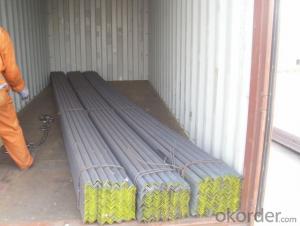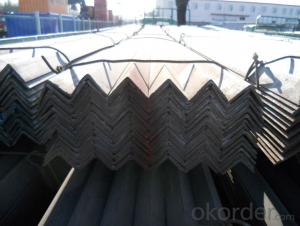Q235 Equal Steel Angle
OKorder Service Pledge
OKorder Financial Service
You Might Also Like
Specifications of Equal Angle Steel
1.Standards:GB
2.Length:6m,9m,12m
3.Material:GBQ235,Q345 or Equivalent
4. Size:
Size (mm) | Mass (mm) | Size (mm) | Mass (mm) |
| 30*30*2.5 | 1.16 | 30*30*3 | 1.373 |
| 30*30*2.7 | 1.246 | 30*30*4 | 1.786 |
Usage & Applications of Equal Anlge Steel
Trusses;
Transmission towers;
Telecommunication towers;
Bracing for general structures;
Stiffeners in structural use.
Packaging & Delivery of Equal Angle Steel
1. Transportation: the goods are delivered by truck from mill to loading port, the maximum quantity can be loaded is around 40MTs by each truck. If the order quantity cannot reach the full truck loaded, the transportation cost per ton will be little higher than full load.
2. With bundles and load in 20 feet/40 feet container, or by bulk cargo, also we could do as customer's request.
3. Marks:
Color mark: There will be color marking on both end of the bundle for the cargo delivered by bulk vessel. That makes it easily to distinguish at the destination port.
Tag mark: There will be tag mark tied up on the bundles. The information usually including supplier logo and name, product name, made in China, shipping marks and other information request by the customer.
If loading by container the marking is not needed, but we will prepare it as customer request.
*If you would like to get our price, please inform us the size, standard/material and quantity. Thank you very much for your attention.
- Q:What is the maximum slope for a steel angle?
- The maximum slope for a steel angle depends on various factors such as the size, shape, and thickness of the angle. However, in general, steel angles are designed to withstand vertical loads and provide stability in structural applications. Therefore, the maximum slope for a steel angle is typically limited to angles less than 45 degrees. Going beyond this angle may compromise the structural integrity of the angle and increase the risk of failure. It is important to consult engineering codes, standards, and specifications to determine the specific maximum slope for a particular steel angle in a given application.
- Q:How are steel angles priced?
- Steel angles are priced based on various factors including the quality and grade of the steel, the supply and demand in the market, the size and dimensions of the angle, and any additional processing or finishing required.
- Q:Can steel angles be used for fencing?
- Yes, steel angles can be used for fencing. Steel angles are commonly used in fencing applications due to their strength, durability, and versatility. They provide a sturdy framework for the fence, ensuring stability and security. Steel angles can be easily installed, and their design allows for different fence styles and heights. Additionally, they are resistant to rust and corrosion, making them suitable for outdoor use. Overall, steel angles are a popular choice for fencing projects due to their structural integrity and long-lasting performance.
- Q:Are steel angles suitable for rooftop installations?
- Yes, steel angles are suitable for rooftop installations. Steel angles are commonly used in construction for their strength and durability. They are particularly useful for rooftop installations due to their ability to provide structural support and stability. Steel angles can be used to secure various rooftop equipment such as solar panels, HVAC units, communication antennas, and satellite dishes. Additionally, steel angles are resistant to weathering, corrosion, and fire, making them a reliable choice for rooftop installations.
- Q:What are the different types of connections used for steel angles in structural applications?
- Steel angles in structural applications can be connected using various types of connections. These connections play a crucial role in maintaining the stability and strength of the overall structure. Firstly, welded connections are commonly used. This method involves fusing the edges of the steel angles together through melting, resulting in a strong bond. Welded connections are ideal for applications that require high strength and rigidity. Secondly, bolted connections provide flexibility as they involve using bolts and nuts to secure the steel angles. This type of connection allows for easy disassembly and reassembly if needed. Bolted connections are often chosen for their ease of installation and maintenance. Thirdly, riveted connections are a traditional method of joining steel angles. This involves inserting a rivet through holes in the steel angles and flaring the ends to secure them. Although riveted connections are known for their durability and resistance to corrosion, they are less commonly used today due to the time-consuming installation process. Next, clip connections utilize metal clips or brackets to attach the steel angles quickly and efficiently. These clips can be welded or bolted to the angles, making them suitable for applications where speed and ease of installation are important. Lastly, gusset plate connections involve using steel plates to connect the steel angles at their intersection points. These plates are typically welded or bolted to the angles, enhancing the strength and stability of the connection. Gusset plate connections are often employed when larger forces and moments need to be transferred. It is essential to consider the specific needs of the structure, including the structural requirements, loadings, and the intended application, when choosing the appropriate connection method. Adhering to design and engineering specifications ensures that the selected connection method is suitable for the desired use in structural applications.
- Q:Can steel angles be used for support beams in warehouse construction?
- Yes, steel angles can be used for support beams in warehouse construction. Steel angles are commonly used in construction for their strength and load-bearing capabilities. They provide structural support and stability, making them suitable for supporting heavy loads in warehouse buildings.
- Q:How do you determine the shear capacity of a steel angle?
- To determine the shear capacity of a steel angle, several factors need to be considered. The shear capacity is the maximum load that the angle can sustain without failure in shear. The first step in determining the shear capacity is to identify the properties of the steel angle, such as the material grade and dimensions. The grade of the steel determines its strength properties, which are crucial for calculating the shear capacity. The dimensions of the angle, including the length, width, and thickness, will also play a significant role in the calculations. Next, it is necessary to determine the critical shear area of the angle. This area represents the portion of the angle that will experience the highest shear stress during loading. The critical shear area can be calculated by considering the location of the applied load and the geometry of the angle. Once the critical shear area is determined, the next step is to calculate the shear stress acting on this area. The shear stress is calculated by dividing the applied load by the area. It is important to ensure that the shear stress does not exceed the allowable shear stress for the specific grade of steel being used. The allowable shear stress is typically provided by design codes or standards. Finally, the shear capacity of the steel angle can be calculated by multiplying the shear stress by the critical shear area. This calculation provides the maximum load that the angle can sustain without failure in shear. It is important to note that the shear capacity of a steel angle may be influenced by other factors such as the presence of holes or welds, which can weaken the structure. In such cases, additional calculations or considerations may be required. Overall, determining the shear capacity of a steel angle involves considering the properties of the steel, calculating the critical shear area, determining the shear stress, and ensuring that it does not exceed the allowable shear stress for the material grade.
- Q:Can steel angles be bent or shaped?
- Yes, steel angles can be bent or shaped. Steel angles are typically made from hot-rolled steel and are commonly used in construction and manufacturing industries. They are versatile and can be easily bent or shaped to fit specific design requirements. The process of bending steel angles involves applying force to the metal, causing it to deform and take on a new shape. This can be done using various methods, such as using specialized machinery like a press brake or by applying heat to soften the steel before bending. The ability to bend or shape steel angles makes them highly adaptable for a wide range of applications and allows for greater flexibility in design and construction projects.
- Q:Can steel angles be used for manufacturing bike racks?
- Yes, steel angles can be used for manufacturing bike racks. Steel angles provide strength and stability required to support the weight of bicycles and withstand outdoor conditions.
- Q:What are the different methods of connecting steel angles together?
- When connecting steel angles together, there are various methods available depending on the specific application and structural needs. Some commonly used techniques include: 1. Welding: Utilizing a welding electrode, welding is an effective and frequently employed method. It involves melting the edges of the angles and joining them together, creating a permanent and robust connection. 2. Bolting: Another popular approach is bolting, which involves using bolts, nuts, and washers to secure the angles in place. This method allows for a strong connection that can also be easily disassembled if necessary. 3. Riveting: Riveting entails the use of metal pins known as rivets to connect steel angles. It requires drilling holes in the angles and inserting the rivets, which are then hammered or pressed to create a permanent connection. 4. Adhesive bonding: Adhesive bonding involves the use of industrial adhesives to connect steel angles. The adhesive is applied to the surfaces of the angles, which are then pressed together. This method provides a durable and corrosion-resistant connection. 5. Mechanical connectors: Mechanical connectors, such as steel clips or brackets, are also suitable for connecting steel angles. These connectors are designed to securely clamp the angles together, providing a rigid connection. When selecting the appropriate method, it is crucial to consider factors such as load-bearing requirements, structural design, and environmental conditions. Consulting with a structural engineer or a professional in the field is recommended to ensure the appropriate method is chosen for the specific application.
1. Manufacturer Overview |
|
|---|---|
| Location | |
| Year Established | |
| Annual Output Value | |
| Main Markets | |
| Company Certifications | |
2. Manufacturer Certificates |
|
|---|---|
| a) Certification Name | |
| Range | |
| Reference | |
| Validity Period | |
3. Manufacturer Capability |
|
|---|---|
| a)Trade Capacity | |
| Nearest Port | |
| Export Percentage | |
| No.of Employees in Trade Department | |
| Language Spoken: | |
| b)Factory Information | |
| Factory Size: | |
| No. of Production Lines | |
| Contract Manufacturing | |
| Product Price Range | |
Send your message to us
Q235 Equal Steel Angle
OKorder Service Pledge
OKorder Financial Service
Similar products
New products
Hot products
Related keywords



























